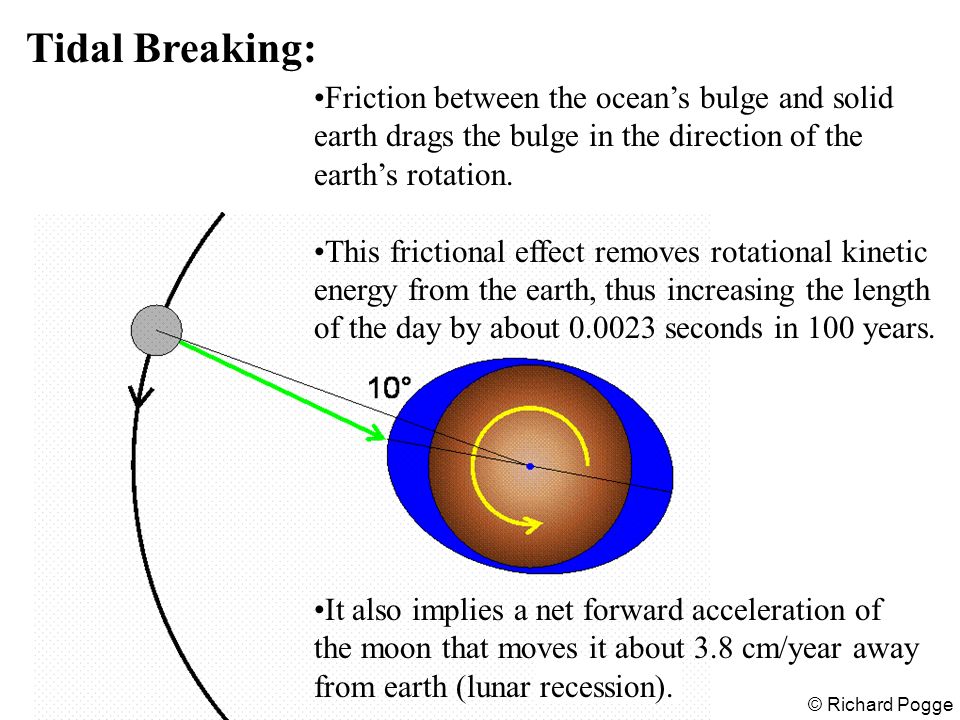Putting the moon in Nairobi about 1 billion years ago. :chuckle:The trend over billions of years...
Last edited:
Putting the moon in Nairobi about 1 billion years ago. :chuckle:The trend over billions of years...
Putting the moon in Nairobi about 100 million years ago. :chuckle:
It isn't. The moon was receding faster in the past and the effect is wearing off as time goes on. :chuckle:If you assume the rate was uniform.
Barbarian asserts, sans evidence, that the moon has receded over billions of years.
It isn't. The moon was receding faster in the past

and the effect is wearing off as time goes on.
The moon draws up tidal bulges, which get offset by the Earth's rotation such that the moon is drawn toward the closer one, accelerating it its orbit. The moon's pull on that closer tidal bulge in turn slows the Earth's rotation. Some people think it is friction that slows the rotation, but that's obviously wrong.
Would you like to learn why?
Tidal rhytmites left a record of that. And yes, it has receded over that time. But it's not constant, because the tidal forces that transfer energy from the Earth to the Moon vary with the coastlines of continents.
This paleontological evidence comes in the form of tidal rhythmites, also known as tidally laminated sediments. Rhythmites have been subjected to intense scrutiny over the last decade or so, and have returned strong results. Williams (1990) reports that 650 million years ago, the lunar rate of retreat was 1.95±0.29 cm/year, and that over the period from 2.5 billion to 650 million years ago, the mean recession rate was 1.27 cm/year. Williams reanalyzed the same data set later (Williams, 1997), showing a mean recession rate of 2.16 cm/year in the period between now and 650 million years ago. That these kinds of data are reliable is demonstrated by Archer (1996). There is also a very good review of the earlier paleontological evidence by Lambeck (1980, chapter 11, paleorotation)
Slichter, Louis B.
Secular Effects of Tidal Friction upon the Earth's Rotation
Journal of Geophysical Research 68(14), July 15, 1963
Actually, as you see, it was usually slower, but it varied over time. Average rate was a little more than half the current rate. It isn't gravity pushing the moon outward. It's the tranfer of kinetic energy from the Earth's rotation, to the moon, as a result of the Moon's tidal drag on the oceans:

(best illustration, worst typo)
In fact, it's much faster than usual now, due to the fragmentation of continents, increasing area of coasts.
You forgot how gravity works; it doesn't push an orbiting body outward. It pulls it inward. The body orbits because the vector of gravity pulling it toward the planet precisely matches the vector moving it forward.

The added energy gained by the Moon (by tidal forces slowing the Earth's rotation) moves it away. The farther out the Moon goes, it gains potential energy (because it takes work to move it to a higher orbit).
BTW, the moon averages about 384,400 km from Earth. Which would be 38,440,000,000 centimeters. At 4 centimeters per year, that would mean 9,610,000,000 years to get to Nairobi, which would be before the solar system formed.
At the actual average, it would be much longer. The actual rate couldn't be much great, because the limiting factor is the amount of energy that can be obtained by tidal forces on the oceans. The mass of the oceans is much less than the mass of the Moon. So it's not going to be feasible to move it that far in a hundred million years as you supposed. By about 2 orders of magnitude.
The moon draws up tidal bulges, which get offset by the Earth's rotation such that the moon is drawn toward the closer one, accelerating it its orbit. The moon's pull on that closer tidal bulge in turn slows the Earth's rotation. Some people think it is friction that slows the rotation, but that's obviously wrong.
Would you like to learn why?
I asked a question to you. I was not responding to him.He asked a question. Seems you are unable to respond with a cogent answer.
Watch, now Barbarian is going to say that the continents lined up carefully to slow the moon's departure. :chuckle:
It's like he totally forgets all the times we've explained all this to him. :chuckle:
Then he just gets flustered and angry before he starts lashing out. :chuckle:
:rotfl:
Don't you get tired of embarrassing yourself?
... you fundamentalists ...
... fundamentalist tripe ...
We put the FUN in FUNdamentalism!artie, maybe you'd be happier at a site that's not owned and run by Christian fundamentalists
We put the FUN in FUNdamentalism!
Don't atheists know that they are fundamentalists of the worst kind?
Richard Dawkins is an expert on evolutionary biology ...
The Simpsons seems about your speed. Probably where you learn about science.Reminds me of a Simpsons episode...
The Simpsons seems about your speed. Probably where you learn about science.
All depends on who and why. Richard Dawkins is an expert on evolutionary biology and quite the humanitarian but his hardcore atheistic stance and fumbling forays into belief and addressing/criticizing that are amateurish and annoying for certain. Otherwise, there's plenty an atheist or "non believer" be it agnostic et al who are hardly hardline about it.
